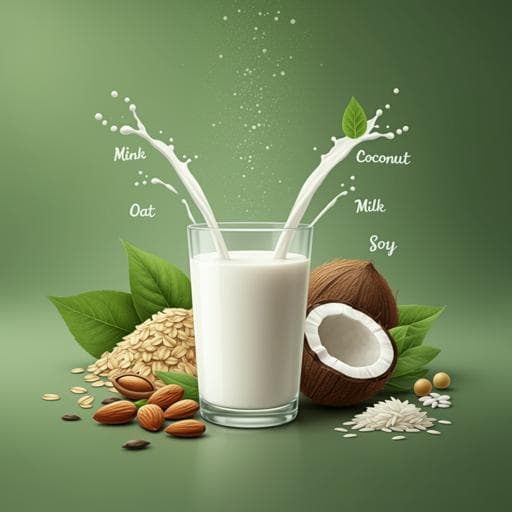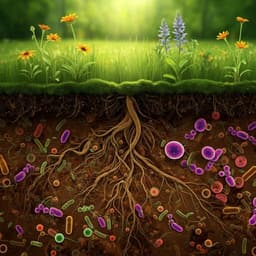
Food Science and Technology
How animal milk and plant-based alternatives diverge in terms of fatty acid, amino acid, and mineral composition
S. S. Moore, A. Costa, et al.
Discover the nutritional showdown between plant-based beverages and traditional milk! This study by S. S. Moore, A. Costa, M. Pozza, T. Vamerali, G. Niero, S. Censi, and M. De Marchi reveals how soy drinks measure up in protein content against almond, oat, rice, coconut, and cow/goat milk, highlighting significant differences in nutritional value. Don't miss these surprising insights!
~3 min • Beginner • English
Introduction
Dairy products are key nutrient sources globally, supplying substantial proportions of dietary calcium, fat, and protein, and are widely recommended in dietary guidelines. Nonetheless, fresh milk consumption is declining in Western countries, with increased uptake of plant-based beverages (PBB), often marketed as healthier and more sustainable than milk. The nutritional quality of PBB is variable and often inferior to milk, especially regarding proteins and minerals (notably iodine). Many PBB are fortified to address micronutrient gaps, but labeling may not reflect actual contents. Given milk’s role as a high-quality protein and mineral source, this study aims to quantify gross composition, detailed fatty acid and amino acid profiles, and mineral contents in multiple brands of almond, oat, rice, coconut, and soya beverages versus cow and goat milk, and to identify which PBB, if any, approximate animal milk’s nutritional profile. The broader context includes concerns about bioavailability (e.g., antinutrients), consumer guidance, and potential public health implications (e.g., iodine adequacy).
Literature Review
Prior work indicates PBB generally have poorer nutrient profiles than cow’s milk, with low iodine unless fortified (e.g., via algae). Studies often rely on label declarations, which can be inaccurate. Protein quality measures such as PDCAAS and DIAAS consistently rate milk proteins highly (milk PDCAAS ~1.00; DIAAS ~1.45), while most PBB proteins score lower; soya is an exception with relatively high PDCAAS/DIAAS but remains limited in methionine. Research also suggests that saturated fat from dairy does not straightforwardly translate to higher cardiovascular risk, and that replacing SFA with PUFA lowers LDL and can raise HDL. Oat- and rice-derived components (avenanthramides, γ-oryzanol) have reported antioxidant/anti-inflammatory properties, but their presence post-processing in beverages is uncertain. Iodine adequacy in populations is linked to dairy intake, and reduced dairy consumption without appropriate fortification may increase the risk of deficiency.
Methodology
Design and sampling: 60 plant-based beverages (12 each of rice, oat, soya, almond, coconut; two brands later excluded due to incomplete data), 8 UHT whole cow milk, and 8 UHT whole goat milk were purchased in Northern Italy (Vicenza province) and analyzed (Feb–Mar 2022). Only unfortified products (no vitamin/mineral fortification) were included to enable fair comparison; some PBB with added sugars and salt (as labeled) were included to reflect market products. Beverages were grouped as animal (cow, goat), PBB (rice, oat, soya, almond, coconut), crop (rice, oat, soya), legume (soya), cereal (rice, oat), fruit (almond, coconut), monocots (rice, oat, coconut), and dicots (soya, almond). Analytical methods: Gross composition measured on freeze-dried samples. Ash by muffle furnace at 550 °C (AOAC 945.46). Crude protein via Kjeldahl (AOAC 991.20). Lipids via acid hydrolysis followed by ether extraction (SOXTET). Sugars (glucose, fructose, lactose) extracted (acid/Carrez reagents) and quantified by HPLC (Aminex HPX 87H, RI detection). Total carbohydrates were taken from product labels (not directly quantified). Amino acids (His, Arg, Ser, Gly, Asp, Glu, Thr, Ala, Pro, Lys, Met, Tyr, Val, Cys, Ile, Leu, Phe, Trp) were hydrolyzed and derivatized with AQC and quantified by RP-HPLC with DAD; Trp by alkaline hydrolysis per EU Directive 2000/45/EC. Fatty acids were extracted (hexane:isopropanol), esterified (methanolic H2SO4), and quantified by GC-FID (Omegawax column), identified against FAME standards; some overlapping peaks limited resolution for certain omega-3 and omega-6 species. FA were grouped by saturation (SFA, MUFA, PUFA, USFA) and chain length (SCFA, MCFA, LCFA, VLCFA). Minerals (Ca, Cr, Fe, P, Mg, Pb, K, Cu, Se, Na, Zn, S, and I) were measured after microwave digestion; ICP-OES for most minerals (per Poitevin), and ICP-MS for iodine (after ammonia treatment). Several trace elements were below detection across samples and excluded from analyses. Statistics: Due to non-normality, medians were compared using Mann–Whitney U tests for group contrasts. Coefficients of variation (CV%) were computed per beverage type. Multivariate analyses included PCA (traits with loadings >0.5 after z-score normalization) and supervised Linear Discriminant (LD) analysis (XL-STAT and R packages FactoMineR and MASS).
Key Findings
- Protein and amino acids: Soya beverages had the highest protein among PBB (3.47%), comparable to cow (3.42%) and goat (3.25%) milk. Other PBB were substantially lower (e.g., oat 0.69%, almond 0.85%, rice 0.12%). Essential amino acids were generally higher per volume in animal milk than soya, except phenylalanine. Soya exceeded milk for some nonessential amino acids (Arg, Ser, Gly, Asp, Ala, Cys). Variability (CV) was much lower in milk than PBB across amino acids (e.g., Cys CV 7–10% in milk vs. 19–46% in PBB). Protein quality metrics: reported DIAAS (adult reference) were milk 1.45; soya 1.08; coconut 0.72; oat 0.59; rice 0.43; almond 0.39. PDCAAS (literature ranges): milk ~1.00; soya 0.84–1.00; coconut 0.89–0.94; oat 0.54–0.57; almond 0.40; rice 0.37–0.59, indicating PBB proteins (except soya) are generally lower quality.
- Lipids and fatty acids: Total lipids were highest in animal milk (cow 3.55%, goat 3.72%). PBB ranged lower (oat 0.37% lowest; almond 1.99% highest among PBB; soya 1.60%; coconut 1.73%; rice 0.39%). Animal milks had a much higher SFA fraction (~72%) than most PBB (9.59–17.92%), except coconut-based beverages (~93% SFA) and very high MCFA. PBB had substantially higher USFA and PUFA fractions; C18:2n6 (linoleic acid) was significantly greater in PBB, particularly soya and to a lesser extent oat. C18:3n3 (alpha-linolenic) did not differ significantly between PBB and milk overall, but was higher in soya among PBB. Coconut’s FA profile (high C12:0 ~47% and C14:0 ~17.8%) differed from other PBB and, in some respects, approximated milk’s chain-length distribution, but with MCFA predominance and controversial health implications.
- Carbohydrates and sugars: Rice beverages had the highest carbohydrates (12.6%), followed by almond (8.2%) and oat (8.0%); soya (1.55%) and coconut (1.95%) were lower. Lactose was present only in animal milks (cow 4.72%, goat 4.31%). Glucose was highest in rice (3.12%); fructose highest in almond (1.02%). Many PBB contained additives: 73% added salt, 23% added sugar, and 67% at least one other additive (e.g., gums, oils, flavors), affecting glycemic load and overall nutritional quality.
- Minerals and iodine: Iodine was detected only in cow and goat milk (about 242 and 377 µg/kg, respectively), consistent with prior reports and the exclusion of fortified PBB from the study. Overall, minerals were higher in milk than PBB, with soya showing the highest mineral content among PBB. Approximate calcium comparisons indicated milk at roughly 1000 mg/L vs. soya at ~260 mg/L (unfortified). Rice beverages were mineral-poor (e.g., very low Mg, K, S; low Ca, P, Na). Sodium levels were higher in some PBB (oat, coconut) likely due to added salt.
- Overall nutritional profile: PBB (except soya) exhibited low protein, mineral, and lipid contents relative to carbohydrate content, reducing nutrient density per energy unit. Antinutrients (e.g., phytates in cereals, nuts, legumes) may further reduce mineral bioavailability, potentially compromising calcium, zinc, and iron absorption.
- Variability and classification: PBB showed high between-brand variability (high CVs) compared with the relative standardization of milk. PCA (PC1 50.6%, PC2 37.0%) separated animal milks from PBB and distinguished soya from other PBB. LDA achieved 100% correct classification of beverages; most discriminant traits included FA saturation groups (USFA, PUFA, MUFA, SFA), C18:1n9, C16:0, and Glu.
Discussion
The study addressed whether plant-based beverages could nutritionally substitute animal milk by examining not only gross nutrient quantities but also detailed amino acid and fatty acid profiles and minerals, alongside variability and bioavailability considerations. Results show that, aside from soya, most PBB contain substantially less protein and essential amino acids and have lower mineral contents (notably iodine and calcium) than milk. Even soya, while closer in protein quantity and profile, generally provides poorer protein bioavailability (lower DIAAS/PDCAAS) and less calcium and iodine without fortification. Fat quality differs: PBB typically have lower SFA and higher PUFA/USFA, which are often viewed favorably for cardiometabolic health; however, the benefits may be offset by added sugars, higher glycemic loads, and antinutrients that hinder mineral absorption. Coconut beverages, despite high SFA, are enriched in MCFA, which have distinct metabolic handling and uncertain implications for cardiovascular risk. The high variability across PBB brands challenges consumer expectations and complicates informed substitution of milk. Multivariate analyses confirmed distinct compositional clustering: animal milks clearly separated from PBB, and soya-based beverages differed from other PBB, underscoring that PBB are not nutritionally interchangeable either with milk or among themselves. Public health implications include potential risks for iodine and calcium inadequacy if dairy is replaced with unfortified PBB, especially in vulnerable populations (infants, pregnant/lactating women, elderly).
Conclusion
Plant-based beverages generally do not match the nutrient density of cow or goat milk. Soya-based beverages are the closest alternatives in terms of protein quantity and amino acid composition among PBB but still fall short in minerals such as iodine and calcium and may have lower protein bioavailability. Other PBB (almond, oat, rice, coconut) have significantly lower protein and essential amino acids; coconut partially resembles milk in fatty acid chain-length distribution but is SFA-rich and compositionally distinct. Given high product variability and the presence of antinutrients impairing mineral absorption, unfortified PBB are not complete substitutes for milk, particularly for iodine, calcium, and phosphorus. Future work should prioritize improving bioavailability (e.g., reducing phytates), standardizing formulations, evaluating effective and stable fortification strategies (especially iodine and calcium), and assessing post-processing retention of purported beneficial phytochemicals. Consumer guidance should emphasize nutrient differences and the role of fortification, particularly for at-risk groups.
Limitations
- Market scope and timing: Samples were sourced from a single region in Italy within a limited timeframe; generalizability to other markets may be constrained.
- Fortification excluded: Only unfortified products were analyzed to ensure fair comparison, which may not reflect typical consumer purchases where fortification is common.
- Carbohydrate measurement: Total carbohydrates were not directly quantified; values were taken from product labels, which can be imprecise.
- Analytical constraints: Some fatty acids overlapped in GC, limiting resolution of specific omega-3 and omega-6 species. Several trace minerals were below detection limits across products.
- Bioavailability not directly measured: Protein and mineral bioavailability was inferred from literature (DIAAS/PDCAAS, antinutrient effects) rather than measured in vivo for these products.
- High variability among PBB: Large inter-brand variability reduces precision of estimates for specific PBB categories.
Related Publications
Explore these studies to deepen your understanding of the subject.







